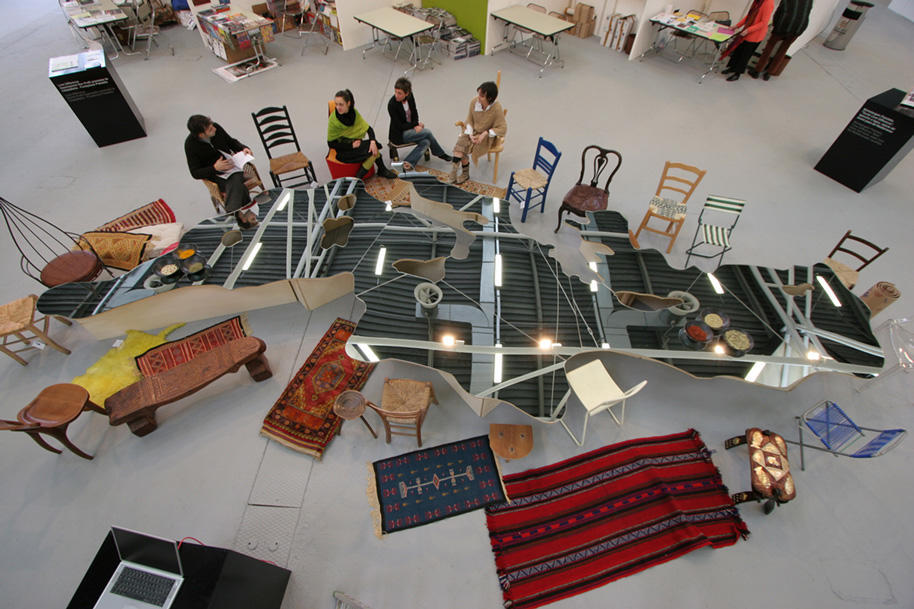
Beirut
Flight 405
Galerie Sfeir-Semler
April 9–June 18, 2005
“The Mediterranean is an absurdly small sea,” wrote novelist Lawrence Durrell in The Alexandria Quartet. “The length and greatness of its history makes us dream it larger than it is.” Durrell banked much of his literary career on exploiting the Mediterranean’s slippage in mental size, dreaming it not only larger but sensuous and full of faded grandeur.
Italian artist Michelangelo Pistoletto takes a different approach. Where Durrell was fuzzy, Pistoletto is clear. For the installation Love Difference, part of Flight 405, the debut exhibition at Galerie Sfeir-Semler’s new outpost in Beirut, he reproduced the Mediterranean in miniature, building a mirror-topped, low-leveled conference table that reflects the exact shape of its craggy contours. A motley collection of some twenty chairs, pillows and carpets surrounds this table, each representing a country with a Mediterranean coast. In its cartographic accuracy, Pistoletto’s installation counters one myth about the Mediterranean being limited to a posh European preserve.
But that is only one myth. Another paints the Mediterranean as an always latent utopia, and the art world in particular tends to embrace the idea (witness such projects as Mediterranean Encounters, Mediterranean Metaphors, and The Other Mediterranean). The idea behind Love Difference — that a progressive political and artistic movement can be forged by linking Mediterranean countries and cultures together — is debatable. But in calling attention to the spiky political and ideological motivations stuck to the backside of regional categorizations, the work nonetheless proved a strong anchor for Flight 405.
Sfeir-Semler pulled nine international artists into a sustained and coherent meditation on identity and locality. The title of the show added some speed to the otherwise academic theme by injecting the idea of temporal and spatial distance.
Japanese photographer Hiroyuki Masuyama captured the journey from Paris to Beirut literally by snapping pictures out a plane window every twenty seconds, then blending the shots into a single and seamless panoramic image.
On a more theoretical level, Walid Raad and the Atlas Group presented a new suite of photographs called Sweet Talk. The series builds on artist-writer Jalal Toufic’s idea of resurrection, whereby a culture’s referents are withdrawn in the event of an overwhelming disaster (such as civil war in Lebanon) and must be resurrected to restore a sense of continuity. Raad’s images have two components: an original black and white photograph tucked into the corner of the frame, and a revamped, revised and revisited version in bold color at the center. Between them is a space of twelve years. What has been tweaked or subtracted from the images to make the past conform to the present? What continuity persists between the two?
Though Galerie Sfeir-Semler has been up and running in Hamburg for twenty years, the Beirut branch seems to be less a business venture than a labor of love. The force behind the gallery, Andree Sfeir-Semler, is keen on cultural exchange, but her approach bears no trace of tokenism or regional essentialism. She seems intent on insisting that the quality of work determine the exhibition program above all else. She has a distinct aesthetic — strictly minimal, strictly conceptual — which means the old masters of Lebanese painting, for example, might not find her gallery a hospitable venue. And so what? Better to have a point of view that’s clear and harsh than fuzzy and forgiving. A gallery is a commercial business, after all, not a charity.
Indeed, Flight 405 looks good. It fills the sparsely furnished, austerely white, 1,000 square meter space well. Expectations of curatorial brilliance might typically be low for a show like this — bound as they are by market concerns, with late-season clearance sales masquerading as collective exhibitions — but the show was thoughtfully and seriously done. Alfredo Jaar’s six piece light box installation was spread stealthily throughout the space, echoing the phrase “Teach Us to Outgrow Our Madness” like a sad and subtle refrain. Flight 405 also established a surprising number of aesthetic and conceptual threads linking Akram Zaatari’s video Desert Panorama, for example, to Elger Esser’s moody and evocative photographs of salt mines in North Lebanon.
Sfeir-Semler commissioned several artists, including Esser, to create work specifically for this show. Not all are as strong as his. Till Krause, who otherwise creates artwork out of intelligent adventures in mapping invisible urban experiences, churned out a little walking project about food in Beirut that was lame to look at and dull to consider: interesting theory, terrible execution, and the effort came across as half-baked at best. Also disappointing was Emily Jacir’s Ramallah/New York, which is for reasons unknown being exhibited in three shows simultaneously. The two channel video has none of the punch evident in previous works such as Sexy Semite and Where We Come From, both of which are as clever and fun as they gracefully slice a knife into your gut and twist. By contrast, Ramallah/New York seems to actually get stuck in the banality it tries to ponder.
Only Amal Kenawy’s work suffers unfairly from a crammed installation. (Elements from two different projects, The Room and The Journey are jammed together with a suite of drawings, and the results are far more incoherent than other exhibitions of the artist’s work elsewhere.) Kenawy’s vision is big, and her performances and installations could benefit from the sheer space Sfeir-Semler provides. Let’s hope next time she gets a bit more room to work with.